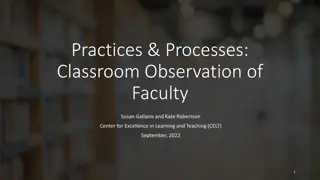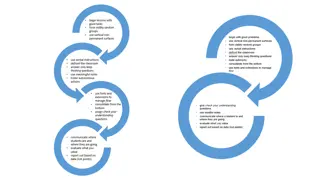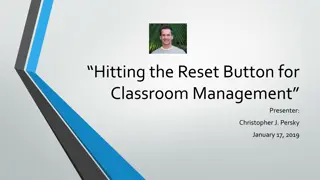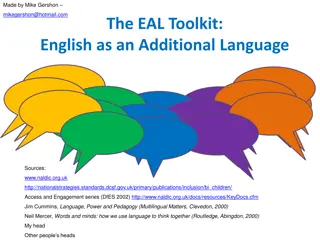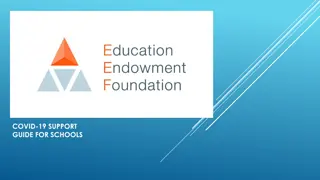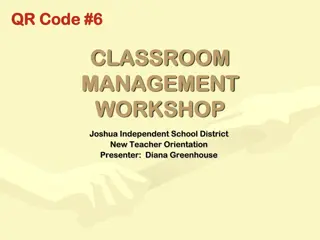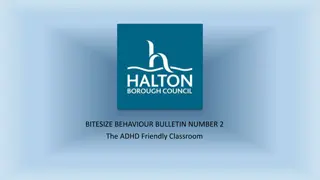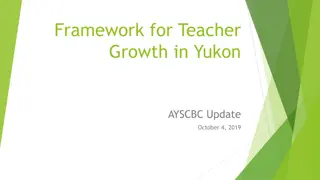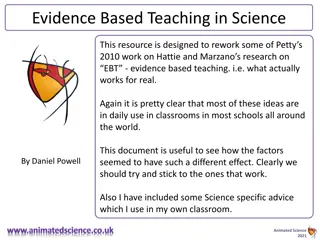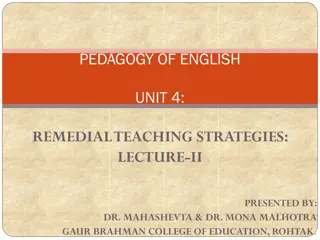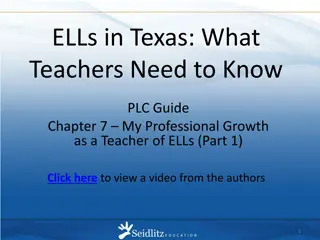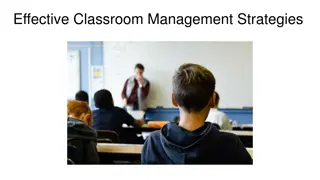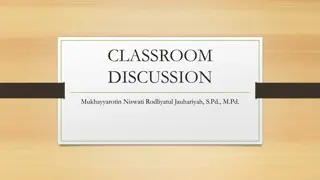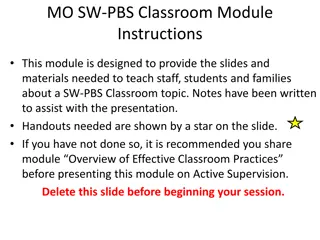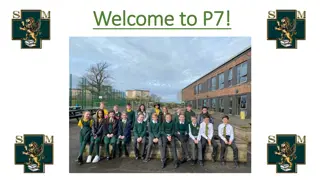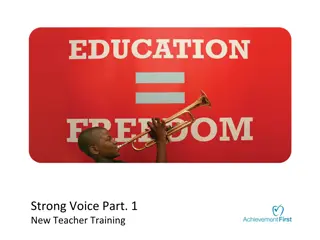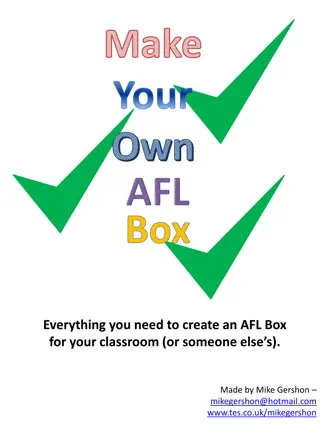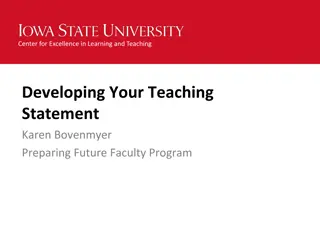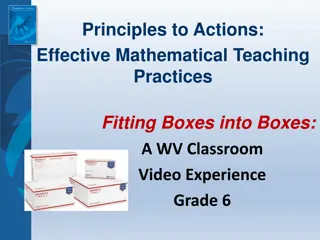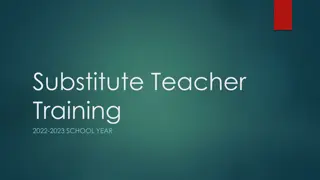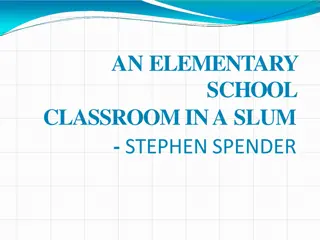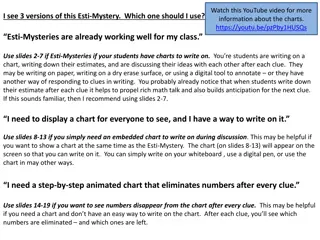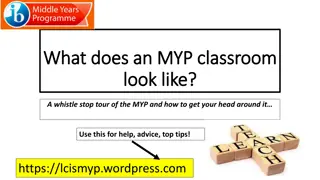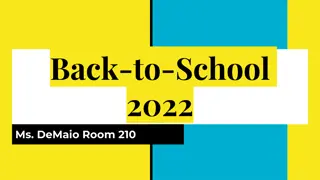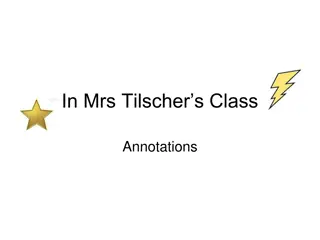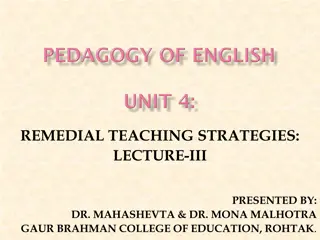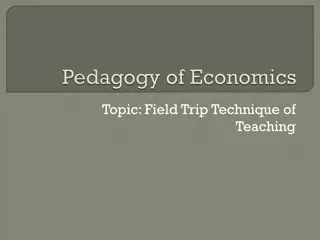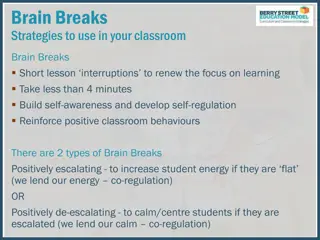Effective Teaching Strategies for Classroom Success
Start every lesson with a Strong Start by setting high expectations and fostering positive relationships. Implement the STAR technique to maintain exceptional behavior and attention in the classroom. Utilize Cold Call and Wait Time strategies to increase student engagement and participation. These effective teaching habits are essential for creating a successful learning environment.
Download Presentation

Please find below an Image/Link to download the presentation.
The content on the website is provided AS IS for your information and personal use only. It may not be sold, licensed, or shared on other websites without obtaining consent from the author. Download presentation by click this link. If you encounter any issues during the download, it is possible that the publisher has removed the file from their server.
E N D
Presentation Transcript
FHES Effective Teaching Habits FHES Effective Teaching Habits
Strong Start High expectations and great relationships Exceptional behaviour for learning and great relationships Rationale: The start of a lesson sets the tone for the entire lesson. Using the FHES greeting routines will help you to ensure that you are your colleagues have a calm and purposeful start to the lesson, where learning begins immediately. Steps to success with Strong Start 1. Have work ready for students as soon as they enter the classroom (a Do It Now task) that they complete in silence, with a timer running to set high expectations of what is to be completed and in what time frame 2. Stand at the doorway to your classroom, side on, so you can see into the classroom and out into the corridor. Assertively and warmly address any uniform issues or behaviour issues as students walk past 3. Greet students positively, prompting them to complete the Do It Now task as they enter in silence 4. Remain at the classroom door until the last student has left the corridor. Remember this is only your default position and doesn t mean that you can t or shouldn t move from it if necessary. 5. Complete the register whilst the students are working on the Do It Now task and begin to circulate to check for understanding.
STAR Exceptional behaviour for learning and great relationships Rationale: Lesson time is often lost getting students attention. STAR is the FHES method used to ensure that all students attention is where the teacher wants it to be, quickly and effective. By all using the same method, students know what they need to do in every classroom. Steps to success with STAR 1. Use the STAR technique every time you want students to be silent and listening to you as the teacher, or one of their peers. This may mean that you ask for STAR behaviours many times in a lesson. This is good practice. 2. Model to the students the expectations when you ask for STAR behaviours and practise it with new classes, until they have mastered the expectations. 3. Use a countdown, with positive language, until your class has mastered the expectations without needing one. For example; STAR behaviours please, in 3, thank you to those that I have sitting up straight, 2, thank you to those that I have tracking me in silence, however, I am still waiting for 100%, and 1, thank you 4. Keep modelling STAR behaviours until you don t need to use the countdown with the class, and it becomes a habit for the students
Cold Call and Wait Time The Power of Planning and Explanation High Expectations Responsive Teaching Rationale: Thinking ratio and participation ratio are critical in lessons. Too often students can appear that they are learning, but cold call ensures that students are mentally on in lessons and having to think about every question asked. Wait time increases thinking time. The average teacher waits just 1.5 seconds before taking an answer. Allowing wait time, increases challenge and thinking ratio. Steps to success with Cold Call and Wait Time 1. Explain what Cold Call questioning is to students. Explain that you are often going to ask no hands up questions so that you can target students to check understanding and to see what they are thinking. 2. Pose a question. Pause (wait time) providing thinking time. Then Cold Call using a student s name. All students will have had to think about the question, as they don t know whether it is coming their way or not, increasing thinking ratio. 3. Count to 5 after posing the question to provide thinking time for students. If you want to provide longer wait time, then do so, but stick to the time limit. 4. If asking a hands up question with wait time narrate what you want to see. I am waiting for more hands up before I take an answer . This encourages students to provide an answer and creates a positive learning environment. 5. Write down the questions that you want to ask, and if applicable, who to, when planning the lesson. This ensures a methodical and sequential approach to checking for understanding.
No Opt Out High Expectations Responsive Teaching Rationale: No Opt Out raises the expectations that you have from students answering questions in the classroom. No Opt Out ensures that you aren t accepting answers such as I don t know , or limited responses that aren t correct, increasing the academic challenge and raising the expectations from students in the classroom. You should always strive to get the student to get to the right answer. Steps to success with No Opt Out 1. When a student is being particularly difficult in answering a question, you provide the answer, and ask the student to repeat the answer, increasing their participation ratio. 2. When a student doesn t know the answer, ask another student to provide the correct answer, and then ask the initial student to repeat the answer. 3. When a student doesn t know the answer, you provide a cue to the answer, and the student uses the cue to answer the question correctly. 4. When a student doesn t know the answer, another student provides a cue to the answer, and the initial student uses the cue to answer the question correctly.
Circulate High Expectations Responsive Teaching Rationale: When students are working, circulating the classroom with a clear focus, offers a prime opportunity to get feedback on whether students have understood the content, and your explanation. It also allows you to respond to any issues as they arise, and support/stretch students when required. It also sets high expectations around work completion and effort. Steps to success with Circulate 1. Set the students off on a task. Be seen looking to check that all have started. 2. Move around the classroom, immediately checking on students that you know may struggle to get started, even though they have said that they know what they are doing. Further scaffold the task for those that require it. 3. Provide immediate live feedback on work, should you see any misconceptions, and be prepared to stop the task and re- explain, if more than a few students have misconceptions that can t be dealt with on a 1:1 basis. 4. Circulate to find the best exemplar work to showcase under the visualiser to unpick the success criteria, or alternatively, select work that can be improved under the visualiser as a form of we do modelling.
Right is Right High Expectations Responsive Teaching Rationale: The idea behind "right is right" is that you only say the student is right when the entire answer you are looking for is given. When you reward a student for only giving part of the answer, that student now believes that they don't have to try their best to get your approval. Students are likely to stop challenging themselves when they hear the word right . Steps to success with Right is Right 1. Instead of using the phrases that s correct or that s right when not all of the answer is 100% right, you should use phrases such as "you're almost there, what else am I looking for?" or "can you dive deeper into the problem? 2. Don t finish answers for students. It is too easy to round-up an answer for a student, doing the thinking for the student, rather than probing for the fully right answer. 3. Use simple positive language to reinforce what they have done, but probe further at the same time, until the 100% right answer is given. 4. Get students to work through the steps to the right answer, rather than giving the final right answer. Students need to ensure that they are right through every single step to the final answer. 5. Only accept answers that use the correct tier 3 subject terminology, and if not, ask the student to re-phrase their answer using this vocabulary. For example, say it again, but say it like a geographer would, using key terminology
Name the Steps Subject Passion and Pedagogy The Power of Planning and Explanation Rationale: Name The Steps requires teachers to identify the steps, name the steps, and design the steps. When learning a new process, students should meticulously focus on what to do next and on how to do each step. Students are novices and we can at times assume they know more than they do. Steps to success with Name The Steps 1. First, teachers must identify the steps to solving a problem in the most clear and concise way possible. The steps should be consistent and flow in in a story-like manner. 2. Students struggle to remember more than seven items in a row, therefore, there should not be more than 7 steps. 3. After identifying the steps, present the information to students in a memorable way through naming the steps, creating mnemonic devices, or telling a story. Making the steps memorable or sticky for students will help with their ability to recall the steps in the future. 4. If you can t name the steps, then number steps/stages of processes in an event, an experiment, a calculation, a rule of thumb
Every Minute Matters High Expectations Responsive Teaching Rationale: If you lose 5 minutes of learning time a lesson, each day, you lose two and half hours of learning per week. Respect your students time in your subject through spending every minute of every lesson productively. Use well-rehearsed routines to make sure that lesson time isn t wasted, for example, by students handing out books slowly. Students are at school to gain an education. They can talk and relax at home and at social times. Steps to success with Every Minute Matters 1. Using STAR behaviours to gain students attention minimises lost time waiting for students attention. 2. Rehearse routines for handing out and collecting in books/textbooks/glues and make these competitive, so that you minimise any loss of lesson time. 3. Set timed tasks, challenging students to work hard and complete quality work in the expected time. Setting tasks that are too long in time, reduces challenge and leads to lost minutes that could be spent on feedback/support. 4. Model the success criteria and showcase what excellence looks like in a task, prior to students starting the task, so they are able to produce their best effort at the first time of asking, reducing lost lesson time when students aren t sure of what is expected of them. 5. Have a range of challenging retrieval tasks ready, vocabulary ones work well, should there be any time left at the end of a lesson. 6. Dismiss rows one at a time, when a student on that row gets an answer right. Makes students realise that learning happens right up to the end of the lesson.
Brighten Lines High Expectations The Power of Planning and Explanation Rationale: Brighten Lines is a technique around transitions from students working, to the teacher instructing, back to the students working again. If these transitions are rehearsed, well planned, and the teacher checks the clarity of their instruction, students will maximise time to put into their work, and also be able to produce their best efforts, the first time round. This strategy reduces fire fighting which is when lots of hands go up, when the task is started. Steps to success with Brighten Lines 1. Insist upon silence, eye contact and all equipment down whilst giving clear instructions 2. Model the success criteria of the task 3. Give a clear time limit for the task 4. Clearly state resources required (textbook pages, equipment) 5. Make the classroom conditions explicit and stick to them (silent/paired/group task) 6. Ask one or more pupils to repeat the instructions back to you, as well as the time limit/resources/task conditions (checking the understanding of the task and the clarity of instruction) 7. Very obviously scan the room to check whether students have begun 8. Narrate compliance praise those who begin straight away ( James has started. Well done, Courtney. Thank you for starting Amir. ) 9. Anonymously challenge off-task behaviour ( Just waiting for two pupils to start , 90% of us have begun, let s have 100% )
Show Call High Expectations Responsive Teaching Rationale: Show Call is a type of Cold Call but with written work. Taking written work from students and displaying it to the class under the visualiser maximises academic rigour and accountability for written work in class. You can tailor this to pick specific students to showcase excellence and bright spots in student work. It holds students accountable for doing their best work in class and also provides a positive incentive, as it allows great work to be valued publically. Steps to success with Show Call 1. Circulate the room during a written task to see exemplar student work that you wish the rest of the class to see under the visualiser. This doesn t necessarily need to be the best work, it could be work that you are going to unpick and improve together. 2. Using annotations and highlighting, unpick what they key strengths are in the written work, and the areas for development, using cold call questioning to check all students on their understanding of the success criteria of the task 3. Providing this form of live feedback, can then allow students to make changes to their work in real time rather than after the work has been finished. Therefore stopping a task at a half-way point, or after a paragraph works well. 4. It equally works well after the task has been completed, to feed-forward into the next similar task. On each occasion other students can self-assess and improve their work in green pen, during or after the feedback under the visualiser.
Warm Strict High expectations and great relationships Exceptional behaviour for learning and great relationships Rationale: Warm/Strict is the idea that those two characteristics (being warm and being strict) are not opposites. You can have high expectations, be attentive to details, push students to give their very best all the time and also do so with caring, warmth and affection. This means emphasizing purpose over power and communicating yes there are rules but they are there to help you. Students need to hear that the message isn t do it because I said so but do it because it is beneficial to you and your growth. Steps to success with Warm Strict 1. Narrate the classroom you want to see. Praise those meeting the high expectations and challenge those not meeting them anonymously. James, Charlotte and Mohammed have fantastic STAR behaviours, I am still waiting for 100% though 2. When dealing with negative behaviour, maintain emotional constancy. Remember you are the adult in the room 3. Catch off-task behaviour early and reset it whilst it is still very small and can be addressed with a very small fix so that it does not become larger and require some larger and more emotionally fraught response 4. Whenever you are circulating, and stop to speak to an individual, think about your position and whether it allows you to see all other students, using your teacher radar. This stops off-task behaviour in areas that can t be seen in the room. 5. Always relate the behaviour to the specific student expectation that hasn t been met. This separates the behaviour from the student. 6. By having a personal conversation with the student, they clearly understand what expectation hasn t been met, and this reinforces the high expectations you have of them, and that they can be better.
Everybody Writes High Expectations The Power of Planning and Explanation Rationale: Everybody Writes is a strategy that increases student participation ratio in lessons, increasing the amount that students have to think, adding rigour. By pausing to ensure that all students have written down their thoughts, prior to engaging in a discussion, or a Q&A part of a lesson, all students have had a chance to reflect and put their ideas on paper, and will have to had to think hard. Too often, through questioning alone, some students can coast through lessons. Everybody Writes ensures that coasting doesn t happen. Steps to success with Everybody Writes 1. Explain the expectation that everybody in the room will be writing down their thoughts/ideas/answers, even if they aren t correct. This sets high expectations around writing, and that writing information down supports learning. 2. Give wait time (in the form of writing) to students after posing a question and allow all students to write down their thoughts/answer. 3. Circulate the room during this time to check for understanding, and to choose students to question afterwards or to use for Show Call . 4. By having an answer or thoughts written down, students will feel supported, if they were to be Cold Called . Guide students to refer to their notes during their answer/discussion.
Roots Subject Passion and Pedagogy Power of Planning and Explanation Rationale: Teaching vocabulary explicitly, with clear sequencing and planning through the curriculum, reduces the vocabulary deficit that students have. Roots is a strategy that teaches the morphology and etymology of words, thus allowing word consciousness to improve, thus increasing a students range of subject specific vocabulary. Steps to success with Roots 1. Teach the etymology of the subject specific vocabulary. Breaking down parts of words into their historical meaning allows students to see where the word has come from, and how it has got to the word it is now 2. Teach the morphology and pronunciation of vocabulary 3. Use synonyms and antonyms to help students with to comprehend tier 2 and tier 3 vocabulary 4. Ensure that students have definitions of subject specific vocabulary written down for retrieval purposes 5. Get students to use new vocabulary in context in written form or through spoken answer. Insist on tier 3 vocabulary being used, in the correct context, in verbal answers.
I do, We do, You do Subject Passion and Pedagogy Power of Planning and Explanation Rationale: Modelling makes the abstract success criteria concrete for students. Modelling demonstrates the thought process of us, as expert teachers, for students. It supports not only, what to do , but also how to think , supporting students metacognition. Without careful modelling students have little conception of what the final product, the goal, should look like, and they do not understand the small steps they need to go through to achieve success. Inevitably, without models, their thinking and subsequent work becomes patchy and filled with avoidable errors. Steps to success with I do, We do, You do 1. The I-stage involves the teacher demonstrating to the class how to perform a task or procedure. This could take the form of a live-model when the teacher uses a visualiser, the board or a physical demonstration to talk their students through a new procedure. A pre-written worked-example is another option these are especially useful when they are labelled with the steps students should go through. Models should always be deconstructed in the first instance. The We-stage involves joint construction. In this step, students encounter a second problem which has the same deep-structure as the first problem (that covered in the I stage) but with different surface features. For example, an equation that needs to be solved through the same procedure, or a paragraph about a slightly different topic that requires students to use the same strategy. In the We-stage, teachers and students collaborate on the building of a second example, usually through questioning and dialogue. The You stage involves independent practice. This means that the students work alone on a third, similar problem. This might be a partially completed problem or task perhaps they are given sentence starters or some of the steps are already done for them. Another approach is to ensure that the original model or worked example remains visible to remind them of the steps they need to take. At this stage, you can quietly intervene with individual students who need extra support. The You-stage should not be considered to be automatically under exam-conditions; instead, it is about withdrawing, or fading, some level of support, rather than removing it altogether. 2. 3.
DINT Power of Planning and Explanation Responsive Teaching Rationale: A Do It Now Task or DINT is a task that is ready for students as soon as they enter the classroom. A DINT ensures that learning happens as soon as a student enters the classroom, ensuring no lesson time is lost. A DINT raises the expectations that you have of your students when they enter your classroom. A DINT should always focus on prior learning, so that all students can give the task a go, as the content has been covered before. Steps to success with DINT 1. A small range of quality and effective DINTs gets students into a routine of what is expected of them with each DINT, increasing confidence, effort and student work. This also reduces students cognitive load on entry to the classroom, whilst keeping challenge and expectations as high as possible. 2. DINTs should always be retrieval practice. Through spacing retrieval practice, a DINT can target prior content at the time it would be about to be forgotten by students. 3. Therefore, a DINT that looks at content within the current topic, the previous topic and the previous year (in one go) can be very effective. 4. The content in the DINT should be related in some way to the new learning happening in the classroom in the new lesson. This helps students to relate the new learning to existing schema they have on the topic/subject.
Explain It Subject Passion and Pedagogy Power of Planning and Explanation Rationale: A significant part of a teacher s job is to explain things that they know and understand in such a way that their students might also come to know and understand them. This sounds simple, but to do it well takes time, thought and practise. Avoid the curse of knowledge. We sometimes forget how little our students may know and understand, as we understand the content so well, yet forget how hard it was to learn it the first time round. Steps to success with Explain It 1. A key element of effective explanation is to tether new knowledge to what is already known. 2. Link explanations of new knowledge to existing schema through making comparisons, using analogies and using concrete examples. 3. Script your explanations, so they are sequenced and concise, and don t include inessential information. It is hard for students to keep the narrative of the explanation in their heads if there are constant tangents and incidental information added in. 4. A key aim of explanation is to avoid the split-attention effect. This is when students have to divide their attention between two or more sources of information, at different times, but they can only be understood in reference to each other. 5. Utilise the principles of dual coding. We can take information in through both auditory and visual channels. Therefore, a verbal explanation can be improved with the use of visual prompts.



